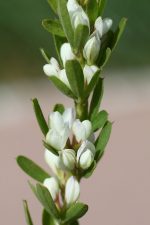 Also called Chinese bush clover, this semi-woody perennial is a member of the pea family, Fabaceae, that also lupines, mimosa, and alfalfa. It is native to China, Korea, Japan, Formosa, and the Himalayas but was introduced into North Carolina from Japan in 1896 and was planted for erosion control, mine reclamation, and wildlife habitat. Chinese lespedza has formed dense stands in new and old forest openings, dry upland woodlands, moist savannas, and old fields and has become invasive in New England, Michigan, and Nebraska, south to Florida and Texas. Plants thrive in full sun, average, medium moist to dry, well-drained soil and tolerate lean soil. USDA Hardiness Zones 6-8
Also called Chinese bush clover, this semi-woody perennial is a member of the pea family, Fabaceae, that also lupines, mimosa, and alfalfa. It is native to China, Korea, Japan, Formosa, and the Himalayas but was introduced into North Carolina from Japan in 1896 and was planted for erosion control, mine reclamation, and wildlife habitat. Chinese lespedza has formed dense stands in new and old forest openings, dry upland woodlands, moist savannas, and old fields and has become invasive in New England, Michigan, and Nebraska, south to Florida and Texas. Plants thrive in full sun, average, medium moist to dry, well-drained soil and tolerate lean soil. USDA Hardiness Zones 6-8
Description: Growing 3-6′ tall from a woody rootcrown with a taproot, the Chinese lespedeza has one to many slender branching gray-green stems bearing leaves composed of three narrowly oblong leaflets .4 to .8″ long. Each leaflet is green above with light colored hairs below and is carried on a hairy petiole. From July to September, 1-4 pea like white flowers with a purple throat appear in the upper leaf axils. Each flower is .1 to .3 ” long and has a calyx with 5 long teeth that often turn purplish green. The fruit is a single seeded green pod that turns tan when mature and can remain viable in the soil for decades.
Control: Chinese lespedeza is very difficult to control due to the longevity of the seed in the soil and the deep root system that makes removing by digging or pulling very difficult except for small areas. Mowing large areas when in the flower bud stage and before seed set can reduce the vigor of the plants but may be limited by the constraints of the terrain where the plant grows. Mowing followed by an application of of herbicides such as triclopyr or clopyralid prior to branching or during flowering can be effective, but many herbicides such as 2,4 D, picloram, and dicamba are not effective. Glyphosate is especially helpful in wet sites. Although resprouting occurs rapidly after burning, late summer burns reduce plant vigor and the supply of seeds. Control measures may be necessary for several years to control the weed and complete eradication may not be possible.
Photo Credit: Dalgial, Wikimedia